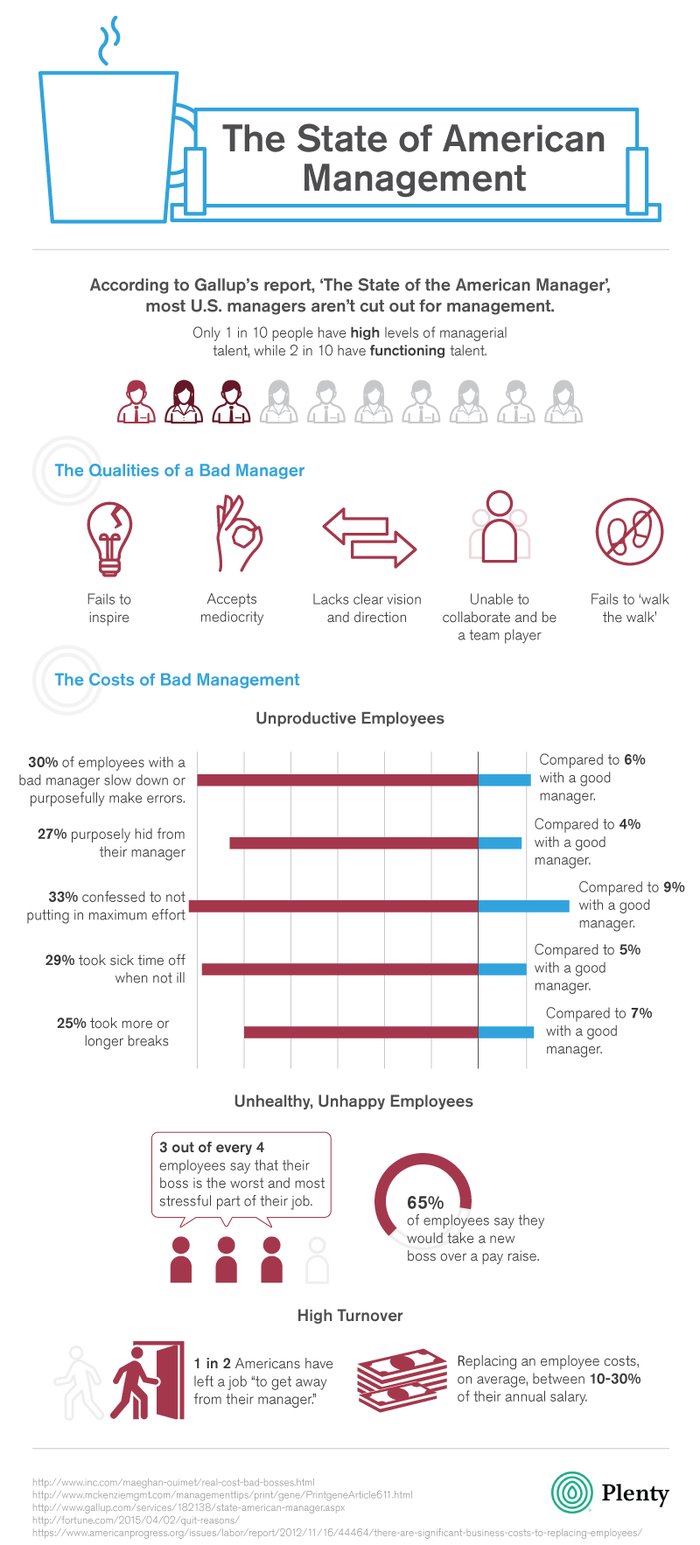It’s called the corporate ladder for a reason; that is, most companies offer a linear progression for their employees, showing a clear path from entry-level to manager. The reasoning? When employees don’t feel there’s opportunity for growth or if they feel like their hard work is unrecognized, they often don’t feel motivated to perform to the best of their abilities. Offering structured, regular opportunities for promotion drives staff to excel, according to research from the Kellogg School of Management at Northwestern University.
However, according to a recent Gallup report, The State of the American Manager, only one in ten people have the skills to effectively manage others, and only another two in ten have functioning managerial skills. As the report states, “the majority of managers working in the U.S. today are wrong for their role.”
Sure, they may have been talented and successful in their previous role, but unfortunately, being next in line to receive a promotion doesn’t necessarily translate to having the skills needed to exceed in that new role. According to Gallup, managers have a rare combination of five specific talents and abilities:
- Motivate their employees
- Assert themselves to overcome obstacles
- Create a culture of accountability
- Build trusting relationships
- Make informed, unbiased decisions for the good of the team and company
In order to identify and promote workers with these talents, the corporate ladder needs a makeover. Here’s a closer look at the consequences of a bad manager, how hiring managers can better identify and develop managerial talent, and how natural leaders seeking promotion can lead from the middle.
The Consequences of a Bad Manager
At best, a bad manager is ineffective and slows the team down; at worst, a bad manager stresses employees out and contributes to employee unhappiness, resulting in the employees quitting and forcing the company to spend time and resources necessary to replace them.

Unsurprisingly, employees suffer the most at the hands of a bad manager, with three out of four employees saying that their boss is the most stressful part of their job. This stress doesn’t live within a vacuum either it also affects employee health. On average it takes 22 months for an employee to shake off the stress and anxiety caused by having a bad boss.
Of course, employee productivity suffers as well when the manager isn’t equipped for the job. In worst case scenarios, a bad boss can cause an employee to quit; if that’s the case, the average cost to replace and train just a minimum wage employee is $3,500.
Finding the right candidates for leadership positions isn’t an easy task, but it can be conquered with the right approach. Closing the gap between employee and manager levels falls to two different parties: the demand side (business leaders and hiring managers) and the supply side (talented employees looking to advance their career).
How to Hire and Promote Top Talent
If 70% of workers don’t have any managerial talent, how can interviewers and hiring managers wade through the bad prospects and the not-quite-ready internal candidates to find talented managers?As it turns out, many successful managers are identified within the top 3-5% of a company’s staff. Known as “high potential employees”, these employees have been identified early on as having the potential, ability, and aspiration to hold successive leadership positions within an organization. Leaders will identify the potential candidates and then screen, and assess them until they’re ready to step into their new role.

Hiring managers and leaders can identify potential managerial talent by looking specifically for someone with a few telling qualities. For example, passion, dedication, and accountability are necessary intangibles when looking for managerial talent. Qualified potential prospects will also balance taking action and initiative with listening closely to team members and higher-ups. Perhaps most importantly, hiring managers should look for the “why” in their candidates - that is, what drives them? What’s their purpose?
How to Lead from the Middle
If “climbing the ladder” describes workers being promoted to managerial positions, it stands to reason that there are promising employees with managerial talent who just haven’t made it to that rung of the ladder yet. So how can they pull themselves up through the ranks and make themselves visible to hiring managers?

As the Gallup report shows, two out of ten people have “functioning talent”, and when developed correctly, can become a strong manager. Despite only showing “basic” management talent, the two out of ten showing functioning talents (combined with the 20% currently in management roles that demonstrate a high level of competency) contributed to a 48% higher profit for their organization than average managers.
For employees with the ambition to progress in their careers, there are several steps you can take to develop yourself into a prime managerial candidate and stand out.
First, look at the team you have around you, and try to surround yourself with capable people that you’ll be able to collaborate with. (A recent study found that 86% of employees reported learning what they needed to know by collaborating with others.) Along the same lines, develop team-building skills that will help your team work together, and set clear expectations for what your team’s goals and priorities should be at any given time.
You can also work to improve your own communication, time management, and financial management skills. Hiring managers value communication skills for their role in motivation and team building, and strong time management skills can increase your company’s effectiveness. And finally, learn to set (and achieve) goals and deliver constructive criticism. Setting and managing goals is an important component of all leadership roles.
It’s clear that businesses need to reform the way they identify and cultivate workers into effective, inspirational leaders. But at the same time, workers who aspire to have a more meaningful role in their organization can take the initiative and develop themselves into stronger employees.
It takes both sides to help a worker climb the proverbial ladder these days, but by identifying potential talent and fostering workers’ initiatives to develop their managerial skills, hiring managers and business leaders can set their companies - and their future managers - up for success.
Share this
You May Also Like
These Related Stories

Three Project Management Techniques To Fuel P2P Fundraising Success

How To Let Go Of Fear



No Comments Yet
Let us know what you think